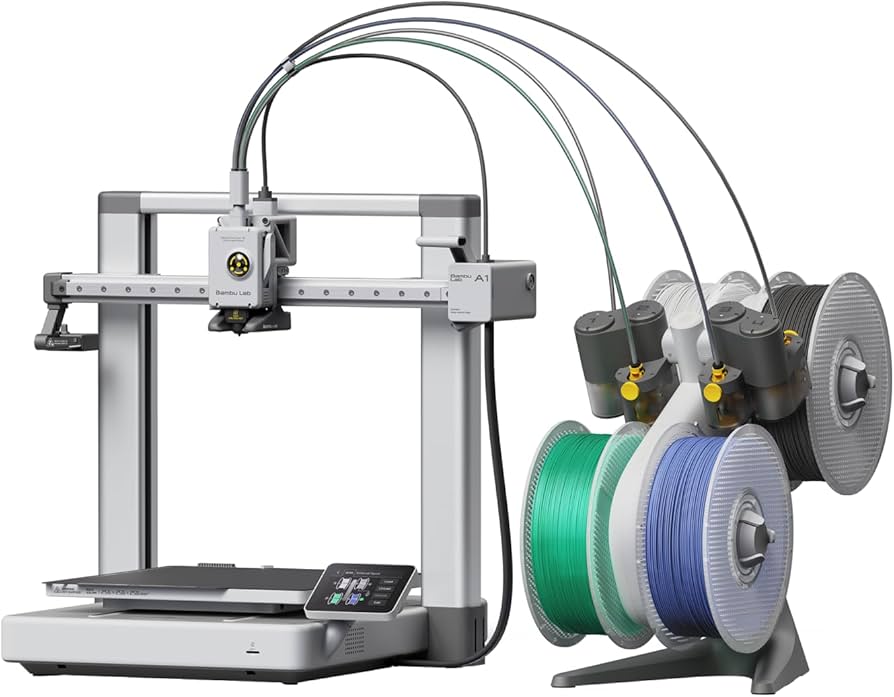Compare Ender 5 vs A1
Comparison between the best 3D printers
Choose the best 3D printer at the best price. The cheapest 3D printers are here.
Buy a 3D printer here with 3D Fila.
 |
 |
|
| Model | Ender 5[BUY Ender 5] |
A1[BUY A1] |
| Printing Material | Filament | Filament |
| Buy Filament for Creality 3D Ender 5 | Buy Filament forBambu Lab A1 | |
| Estimated price | $399,00 | $700,00 |
| Manufacturer | Creality 3D | Bambu Lab |
| Release Year | 2020 | 2023 |
| Print Volume [mm] | 220x220x300 | 256x256x256 |
| Printer Size [mm] | 485x510x552 | 385x410x430 |
| Weight [kg] | 11,8 | 8,3 |
| Power Loss Recovery | YES | YES |
| Enclosed printer | NO | NO |
| Bed Leveling | Manual | Automatic |
| Filament End Sensor | NO | YES |
| Bed type | Heated | Heated |
| Power supply system | Bowden | Direct Drive |
| Standard nozzle | 0,4 | 0,4 |
| Maximum Nozzle Temperature [°C] | 255 | 300 |
| Maximum Bed Temperature [°C] | 100 | 100 |
| Maximum printing speed [mm/s] | 180 | 500 |
| Filament holder | YES | YES |
| Camera for supervision | NO | NO |
| Recommended filaments | PLA, TPU, ABS, PETG | PLA, PETG, TPU, PVA |
| Recommended slicers | Cura, Simplify, Slic3r | SuperSlicer, PrusaSlicer, Cura, OrcaSlicer |
| Maximum Resolution [mm] | 0,1 | 0,1 |
| Processor | 32 bits | |
| Display | Mono | Touchscreen 3,5 |
| Power Supply | 24V / 360W | 350 W |
| Connectivity | SD / USB | Wi-Fi, Bambu-Bus, Cartão Micro SD |
| Operating systems | Windows, Mac, Linux | Windows, Linux, Macbook |
| Date of registration in the system | 2021-04-15 | 2024-07-17 |
| Release date | 2020 | 2023 |
| Extra features | Crealitys Ender 5 stands out with a solid frame and a larger 220 x 220 x 300mm print volume. Its assembly is simple and quick, offering high print quality and speeds of up to 80mm/s. With a magnetic bed, it makes it easy to remove prints. Notable for being hackable and expandable, the Ender 5 continues Crealitys innovative tradition in the affordable 3D printer market. Equipped with a 350W/24V Meanwell power supply, it heats up quickly, in addition to having efficient cable management and modified Marlin firmware. Its unique design includes dedicated stepper motors for each axis and smooth movement on the Y axis, providing more consistent and detailed prints. | The BambuLab A1 printer features fully automatic calibration, multi-color printing with the AMS system, active flow rate compensation, quick nozzle change with a clip, active motor noise cancellation, a build volume of 256x256x256 mm³, a maximum extruder temperature of 300°C, and a heated bed of up to 100°C. In addition, it has high precision, a machine health management system and an intuitive 3.5-inch touchscreen interface. |
| Support for multiple colors and materials (AMS and CFS) | NO | YES |
Notes * |
||
| Cost-benefit | 7 / 10 | 7 / 10 |
| Hardware | 1.5 / 10 | 4.2 / 10 |
| Tela | . | . |
| Print volume | 3 / 10 | 4 / 10 |
| Performance | 1 / 10 | 4 / 10 |
| [BUY Ender 5] | [BUY A1] |
Conclusion |
| In conclusion, when comparing the Creality 3D Ender 5 and the Bambu Lab A1, several key distinctions emerge that cater to different user needs and preferences. The Ender 5 is a budget-friendly printer that offers a good cost-benefit ratio, making it an attractive choice for beginners or hobbyists. Its print volume is slightly smaller, and it relies on manual bed leveling, which may require more user involvement. However, its solid frame, ease of assembly, and hackability provide an appeal to those looking to customize their printing experience. It performs reliably within its limitations, delivering decent print quality and speed for the price point. On the other hand, the Bambu Lab A1, while more expensive, offers advanced features such as automatic bed leveling, high printing speeds, and multi-color printing capabilities. Its larger print volume, enhanced temperature thresholds, and supportive user interface through a touchscreen demonstrate its modern design and efficiency. Additionally, the A1's hardware and performance rating suggest a significant advancement in printing technology, making it suitable for more demanding projects or users seeking high precision and advanced functionality. Ultimately, the choice between the two models depends on a user’s budget and specific needs—those seeking a reliable entry-level printer with the potential for growth might favor the Ender 5, whereas users requiring advanced features and superior performance are likely to appreciate the Bambu Lab A1 despite its higher price tag. |

